Trading Technologies: A Beginner’s Guide to Navigating the World of Trading Technologies
Introduction:
As a personal blogger with a deep interest in trading technologies, I have always been fascinated by the way these tools have revolutionized the financial markets. From algorithmic trading to high-frequency trading, the advancements in technology have undoubtedly transformed the way we trade. In this beginner’s guide, I aim to provide an overview of trading technologies, their significance, and how they can be leveraged to enhance your trading strategies. Drawing from my own experiences and insights, I hope to shed light on this exciting and ever-evolving field.
Understanding Trading Technologies:
Trading technologies encompass a wide range of tools, platforms, and software that facilitate the execution of trades in financial markets. These technologies have not only streamlined the trading process but also introduced new possibilities for traders to analyze, strategize, and execute trades efficiently. From charting software to order management systems, trading technologies have become integral to the modern trader’s toolkit.
1. Charting Software:
Charting software forms the foundation of technical analysis, allowing traders to visualize market data and identify trends, patterns, and support/resistance levels. Platforms like TradingView, MetaTrader, and Thinkorswim offer a wide range of customizable charts, indicators, and drawing tools to aid traders in making informed decisions. By utilizing charting software, traders can gain insights into market dynamics and devise effective trading strategies.
2. Algorithmic Trading:
Algorithmic trading, also known as algo trading, involves the use of pre-programmed instructions to execute trades automatically. These algorithms are designed to analyze vast amounts of market data, identify trading opportunities, and execute trades at lightning-fast speeds. Algorithmic trading has gained immense popularity due to its ability to eliminate human emotions and execute trades based on predefined rules. Platforms like QuantConnect and MetaTrader offer tools and libraries for algorithmic trading, empowering traders to automate their strategies.
3. High-Frequency Trading (HFT):
High-frequency trading is a subset of algorithmic trading that focuses on executing a large number of trades within milliseconds. HFT relies on powerful computers, low-latency connections, and complex algorithms to capitalize on small price discrepancies in the market. While HFT is predominantly used by institutional traders, there are platforms like Quantopian and AlgoTrader that provide access to HFT strategies for retail traders as well.
4. Order Management Systems (OMS):
Order management systems play a crucial role in streamlining the trading process by automating order routing, trade execution, and risk management. OMS platforms like Bloomberg’s AIM, Eze EMS, and FlexTrade’s FlexOMS offer comprehensive solutions to manage trading workflows efficiently. These systems enable traders to handle large volumes of orders, monitor positions, and ensure compliance with regulatory requirements.
Leveraging Trading Technologies:
Now that we have explored some key trading technologies, let’s discuss how you can leverage them to enhance your trading strategies:
1. Education and Research:
Before diving into the world of trading technologies, it is essential to gain a solid understanding of financial markets, trading concepts, and technical analysis. Invest time in learning about different trading strategies, risk management techniques, and market indicators. Online resources such as Investopedia, Babypips, and TradingView’s educational section can be valuable references for beginners.
2. Paper Trading:
Once you have a basic understanding, consider practicing your strategies through paper trading or using simulated trading platforms. Paper trading allows you to test your strategies in a risk-free environment, helping you gain confidence and refine your approach without risking real capital. Platforms like TradingSim, Thinkorswim paperMoney, and NinjaTrader offer paper trading functionalities.
3. Start Small and Gradually Scale:
When you feel comfortable with your strategies, it’s time to dip your toes into live trading. Start with a small capital allocation and gradually scale up as you gain experience and confidence. Remember, trading involves risks, and it’s crucial to manage your risk exposure effectively. Set realistic goals, define your risk tolerance, and always have a well-defined trading plan in place.
4. Stay Informed and Adapt:
The world of trading technologies is constantly evolving, and staying informed about the latest advancements is crucial. Follow reputable financial news sources, join trading communities, and engage with fellow traders to exchange ideas and insights. Adaptation is key to success in trading, so be open to learning new technologies and adjusting your strategies accordingly.
Conclusion:
Trading technologies have revolutionized the way we trade, offering innovative tools and platforms to enhance our trading strategies. From charting software for technical analysis to algorithmic trading and high-frequency trading, these technologies provide opportunities for traders to gain a competitive edge. By leveraging these technologies effectively, traders can navigate the financial markets with confidence and make informed decisions. Remember, trading is a journey of continuous learning, so embrace the evolving landscape of trading technologies and enjoy the exciting possibilities they offer.




